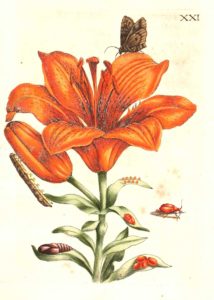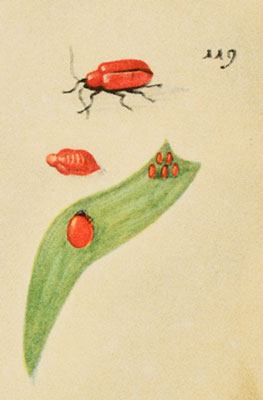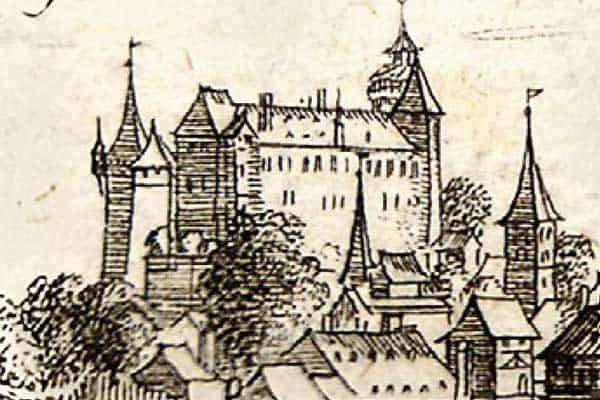PLACES OF REMEMBRANCE IN NUREMBERG
Maria Sibylla and Johann Andreas Graff lived in Nuremberg as a married couple for 14 years and their second daughter was born here in 1678. During this time Maria Sibylla, supported by her husband and Nuremberg civic society, developed her life-long interest: the observation of insects and their natural development.
In some places in Nuremberg this memory is still alive.
THE GARDEN OF THE GRAFF-MERIAN-FAMILY
When the Graff-Merian family came to Nuremberg, garden culture in this imperial city was in full bloom: the owners proudly displayed their green oases, collected flower watercolours and dissected butterflies. These were all ideal preconditions for Maria Sibylla's career and although the Graffs were not one of the old-established families, they were very lucky: They had their own garden.
In her text to print no. XXI, the 21st copper etching of the second caterpillar book, the author informs us: “For when I visited my garden in early July / both to look at the flowers / and to find caterpillars / I found a lot of green mud on the green leaves of said lilies … There I found / in the mud / many small red animals. I took several of them / including their leaves / home / …… but when after several days I examined them again / I found that they had changed in the same such way / as can be seen one this little creature next to a green leaf / which were all beautifully bright red. ...“ (1)
From this entry we know that Maria Sibylla in her Nurem-berg time had a garden – she alone and as a woman from Frankfurt who had only recently moved here? As often, she uses the first person and forgets about the rest of her family (2). But in those days, the garden was rather that of the Graff family.
Unfortunately, the text does not mention where this garden was located. But since 1976, Maria Sibylla’s personal sketch book, kept in St. Petersburg as “Study Book”, has been available as a facsimile edition. Here she entered in handwriting next to no. 119:
Next to the “Schloß Kirchen” (castle church) means next to the chapel of the imperial castle. To use the word “Schloß” for the Imperial Castle is unusual today, but was quite normal in the last decades of the 17th century. On the west side of the castle, the Great Hall was immediately adjacent, but on the east side of the chapel, next to the chapel tower (the so-called “Heidenturm”, heathens’ tower), behind a wall with a wooden door, there is a small garden which was the “Town Judge’s Garden” (5) and not open to the public, and which was used by the castle keeper as his private garden during past decades. (6)
In her Study Book, Maria Sibylla included water colours of the described insects, each on a small piece of parchment: only the “bright red little beetles” (die hoch=rothen Käferlein) and not splendidly colourful butterflies lead to her garden. The only remarkable feature of this beetle is its colour. Apart from that it is rather to be classified as a pest because of its appetite for leaves – for Maria Sibylla it was part of God’s wonderful creation and thus as valuable as even the most striking exotic butterfly. „hoch=rothen Käferlein“ keine prächtig bunten Schmetterlinge. Das einzig Auffallende an diesen Käfern ist ihre Farbe. Wegen ihres Appetits auf Blätter zählen sie bei Gartenfreunden eher zu den Schädlingen – für Maria Sibylla als Teil von Gottes großartiger Schöpfung sind sie jedoch ebenso wertvoll wie der auffallendste exotische Schmetterling.
That is why she also carefully described the development of the "many small red animals" in the "dark, unclean mud" on the green leaves, which she took home with parts of the forage plant for observation.
When the Graff family resided in Nuremberg, the great-uncle of Maria Sibylla’s pupil Clara Regina Imhoff was “Erster Losunger” (treasurer), imperial sheriff and keeper of the fortress (castle). His realm comprised the gardens on the Castle Bastions and the “vineyard” in the south of the castle, looking towards the city, below the Great Hall and the Imperial Chapel. (7)
He could relinquish the small, strategically unimportant garden next to the chapel, because he had a further garden on the outer ward next to the “Neuer Bau” (New Town Quarter - today: Kreuzgassen district) (8).
For the young family with their little daughters, the sunny garden in the immediate vicinity of their house was a great advantage, though – in particular since the plot of the “Golden Sun” was 100% built up and therefore had no space for a “Gräslein” (little lawn).
The garden next to the Chapel can be seen on a colour-washed pen-and-ink drawing by Johann Georg Erasmus (1677) with a bird’s-eye view of the castle from the south. The section of this drawing in the foreground in front of the Chapel tower clearly shows the garden house where the Graff family could find shelter during summer thunderstorms.
Even Graff himself created an illustration of this garden house where his young family could enjoy a view across the wide countryside above the roofs of the city which in summer could often be quite stuffy. When he returned to Nuremberg after his unsuccessful stay with the Labadist congregation in Frisia, without his wife and daughters, he drew a series of views of the landscape surrounding Nuremberg which were then translated into etchings by Johann-Ulrich Kraus and which were very popular for a long time.
One of the small prints, only about 12 x 17 cms in size, the view from the “Poetenwäldlein gegen Nürnberg” (5 = Poets‘ Grove towards Nuremberg), in the background shows a stamp-sized image of the castle seen from the south-west and in it – very tiny and enlarged again here – the garden house leaning on the Chapel tower, with a tree behind – what a clear proof of the quality of Graff’s drawing and of the precise translation of this into a print template by etcher Kraus.
Although in World War II, Nuremberg’s Old Town was largely destroyed, and the Great Hall and the Emperor’s Stables were severely damaged, the small garden house survived the disastrous air raids with only minor damage.
The photograph on the left shows burst window panes and damaged roof tiles. The balustrade of the open ground floor level remained intact. It was called “Dockenbrüstung” (doll’s balustrade), because the turned posts resemble the wooden dolls (“Docken”) of former times. Since the centuries passed by, knowledge was lost about the historic garden owners Merian and Graff. It was only due to several fortunate circumstances that the traces of former family garden in the last third of the 17th century could be rediscovered.
As part of a major investment programme by the Bavarian State Government for the Imperial Castle, the small garden was restored in 2013. It was named after Maria Sibylla Erian, redesigned with plants painted and described by her and opened to the public.
MERIAN’S FLOWERS
As then, the garden is only 170 square metres, but it is a little world of its own. The golden yellow lily, whose description with the bright red beetles had helped us locate the garden, will – as we hope – be part of the colourful flora every summer.
Even a pool as a bird bath and a bed of tropical plants as a reminder of the Merianin's expedition to Surinam have found their place there.
When the “Maria Sibylla Merian Garden” was re-designed, the structure of the garden house was secured. The changes to the building after World War II when the ground floor was closed off, were not (yet) reversed.
Opening up this room to the Garden again with the typical balustrade would be a wonderful present and a joy to all friends of historic garden culture.
For this small house is one of the oldest buildings of its kind in the green oases of Nuremberg. Maybe it is even the oldest surviving two-floor garden house so typical of the historic gardens of Nuremberg.
This garden, then, is a wonderful, living, green and blossoming paradise where we can treasure her memory.
It is a monument in the form of landscape art, one which may be more suitable than a Merian statue. But this delicate garden needs a great deal of care. Therefore it is open to the public – even free of charge – only on Sunday and Monday afternoons from April to October.
Visiting hours of the garden with free entrance
Sundays and Mondays
April to September: 14-18 hrs.
October: 14-16 hrs.
THE LANDSCAPE ARCHITECT INFORMS YOU
How do you manage the balancing act between existing historic design and new requirements
... Historic gardens are also subject to changes over time. If there are structural changes in the overall layout, the garden usually has to be adapted. ….. Sometimes projects like the Maria Sibylla Merian Garden, which we laid out at Nuremberg Imperial Castle in 2013, are also necessary. We knew that there had always been a garden in this location, but we did not have any meaningful documentation on the design and planting. Here, we consciously decided on a new creation in which we used new materials and forms that contrast with the surrounding architecture.
What is your own most important work?
My task as a conservator of historic gardens is primarily to preserve the historic parks and less to redesign them. That's why my involvement in the Maria Sibylla Merian Garden was a special time for me, one that I look back on with pleasure. It still fills me with pride that we were able to dedicate the garden to Maria Sibylla Merian and at the same time create an additional habitat for insects in the interests of species protection. ... All the plants that we have brought into the garden can be found in Merian's books, and most of them are also found in the local countryside. A bonus is that the show garden offers a special ambience, for example at weddings.














